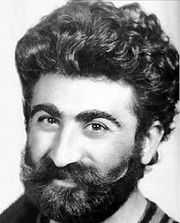Tatul Krpeyan
| Tatul Krpeyan | |
|---|---|
 | |
| Nickname | The Eagle of Getashen |
| Born |
April 21, 1965 Areg, Soviet Armenia |
| Died |
April 30, 1991 (aged 26) Getashen, Khanlar Rayon, Soviet Azerbaijan |
| Allegiance | Armenian Revolutionary Federation |
| Years of service | 1990-1991 |
| Battles/wars | |
| Awards | National Hero of Armenia |
| Relations | Irina Barseghyan-Krpeyan (wife); Aspram Krpeyan (daughter) |
Tatul Krpeyan (Armenian: Թաթուլ Կրպեյան) was the commander of Armenian paramilitary units in Getashen-Martunashen villages in Khanlar Rayon of Azerbaijan during the Nagorno-Karabakh war, from September 1990 until May 1991.
Tatul was born on 21 April 1965 in the village of Areg near the town of Talin, Armenia. He completed his elementary and intermediary education in the Technical School of Talin, where he graduated magna cum laude. After serving in the Soviet army, in 1987 he entered the Faculty of History of Yerevan State University. In his first year at the university, Tatul joined the Armenian-liberation movement. He was also a member of the "Meiatsoom" (Unification) organization, whose efforts were directed to unite Nagorno-Karabakh with Armenia.
In September 1990, he travelled to Nagorno-Karabakh, where the situation continued to deteriorate.[1] Joining the Armenian Revolutionary Federation, Tatul has founded the "Dashnaktsakanner" unit of volunteers in Karabakh.
Tatul headed the self-defense of the sub-district Getashen-Martunashen from September 1990 until May 1991 against Azerbaijani armed forces units and police detachments (OMON). Krpeyan was killed on 30 April 1991 in Getashen during the Operation Ring. He received the highest title in Armenia, the National Hero of Armenia award in 1996. He was buried in Areg, which has been renamed after the hero – Tatul [citation needed]. A tuffaceous monument has been erected in memory of Tatul. The sculptor of the monument is Tariel Hakobian.
Operation Ring
In the spring of 1991 the main battleground of partisan war was the wooded hills to the north of Nagorno-Karabakh where fighters from Armenia infiltrated to Armenian inhabited villages. Tatul Krpeyan led his people to Getashen and Martunashen. On 10 April 1991 the decision was made by the authorities to start operation against these villages.
The Moscow-based human rights group Memorial has reconstructed what happened. On 30 April 1991, 4th Army soldiers and then the Azerbaijani OMON entered Getashen near Shahumian, where Krpeyan was killed, and his people took several soldiers hostage. The OMON raided and looted houses and attacked many of the inhabitants. The dozen or so killed were in their eighties and nineties.[2]
| “ | I remember Tatul well. He was like a ‘fedayi’ (freedom fighter) from Sasoun - broad-shouldered, with curly hair and a thick moustache. Not only did he serve as head of the detachment but he also taught in the local school there. The role he played wasn't limited to just fighting…[3] | ” |
Taking Mashkov prisoner and the Death
From the memoirs of G. Gyurjyan: “Together with Grachev Tatul decided to move forward, holding Mashkov under the gun to make sure that the tanks were leaving the village. Despite the order not to follow them, his deputy, Arthur Karapetyan did follow him, so that, in case of emergency to protect the commander. Mashkov all the time passed the order not to shoot and not to move forward. On their way, they met with tanks and OMON. And here Mashkov managed to lean aside, leaving Tatul defenseless: Tatul was shot at once. Hrach and Arthur, who tried to save Krpeyan, were also killed... Thus Tatul died - a man with an unusually big heart and courage. [citation needed]
Legacy
Many works of art in the modern history of Armenia are dedicated to Tatul Krpeyan. In 2004 Rafayel Sahakian has published a fictional documentary book named Artsvapasht Yerkir (Eagle-idolizing land), dedicated to Tatul Krpeyan. The song "Leran Lanjin" ("Piedmont") was composed by Nersik Ispiryan. "Mayramut Ijav" ("At Sunset") was composed by Ashusgh Gevorg, as well as Ashot Babayan's sonata for cello and piano in 1993, were all reportedly dedicated to Tatul Krpeyan's memory. [citation needed]
References
- ↑ Tatul Krpeyan
- ↑ Thomas de Waal: Black Garden: Armenia and Azerbaijan Through Peace and War - Page 116
- ↑ Harmik Hovsepyan - Fighter from Shushi Battalion
External links
- Tatul Krpeyan profile at armenians.com
- Tatul Krpeyan profile in Italian
- Tatul Krpeyan's profile in French
- Tatul Krpeyan's profile in Spanish
- Tatul Krpeyan's profile in Russian
- Tatul's vita in Russian,English
- "Mad of melancholy" part 1, part 2, part 3 and full
- Report on Tatul Krpeyan
- Family press-conference marking what would have been Krpeyan's 45th birthday
- TV report on what would have been Krpeyan's 45th birthday
- "At Sunset" on YouTube
- "At Sunset" by Sahak Sahakian
- "Piedmont" on YouTube
- "At Sunset" on YouTube